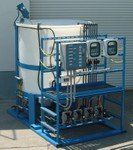BATCH TREATMENT
Batch Treatment
Affordable Batch Treatment Systems For Over 30 Years!
Batch treatment allows the operator precise control of the process cycles and bath. IPEC has been designing and building affordable batch treatment systems for the past 25 years. Our units can be configured for many treatment applications, here are just a few.
- . pH Neutralization
- . Solids Removal - Dissolved and Suspended
- . Heavy Metal Precipitation
- . Oil and water Separation
- . Carbon Treatment
- . Bio-remediation
- . BOD augmentation
- . Aqueous Cleaner Recycling
Batch treatment is perhaps the most efficient and cost effective method of dealing with concentrated liquid wastes and dilute rinse. Batch treated wastes are easier to evaporate, purified by RO or Ion Exchange post-treatment operations. Batch treaters can be used as stand alone recycling systems for processes like tumbler deburr, cleaning operations and for difficult low volume concentrates that tend to foul IX, conventional filters and other treatment systems. Batch treaters are usually combined with a filter press or other de-watering device to remove solids.
A FIELD REPORT BY RON MARLETT Hill Bros. Chemical – San Jose Branch
Recently IPEC completed installation of a wastewater treatment system on a military base. The system is used to treat various metal contaminated streams originating from the base’s large scale plating operation.
Per contract with the government, IPEC was required to operate the system to prove its capability of treating the various spent plating concentrates found at the base. As the chemical supplier I was involved in treating two solutions…..
Solution #1:
The first was a Sulfuric Acid / Sodium Dichromate solution. The initial pH of the 300 gallons to be treated in IPEC’s batch system was well below one and the Hexavalent chrome concentration was very high. Our first step was adding Mag Hydroxide to increase the pH to 3. Magnesium Hydroxide is typically slower than caustic, when increasing pH, however in this case it actually worked faster because it decreased the amount of exotherm and thus allowed for continuous operation. Our second step was adding Sodium Meta-bisulfite to reduce chrome from its Hexavalent form to a less toxic trivalent form which can be precipitated by hydroxides. Our third step was adding Mag Hydroxide to increase the pH to 7.5 and precipitate the chrome. After mixing at 7.5 for 45 minutes to allow for a thorough reaction. DTC was added to the solution to precipitate the remaining chrome and any other trace metals. After mixing another 20 minutes, we discharged the solution from the batch treatment tank to the filter press. The effluent, (tap water clarity in appearance), was discharged to a 35,000 gallon day tank awaiting testing and final disposal to the sewer. The filter cake went to the sludge dryer and was sent for disposal.
Solution #2:
This was an Electroless Nickel plating bath concentrate. 25 gallons of this highly complex concentrate, (pH 4), was added to the batch treatment system. It was then diluted with 350 gallons of water due to the very high metal concentration. Our first step was to increase the pH of the solution to approximately 9.5. This was achieved by using Mag Hydroxide to increase the pH to 8 and then “topping” off with Sodium Hydroxide to reach 9.5. After mixing the solution while at 9.5 and noticing near complete precipitation, we “polished” with DTC, mixed, and discharged to the filter press. As with the chrome solution, the effluent was crystal clear and was sent to the storage tank awaiting testing and discharge to the sewer. The dry filter cake was disposed of.
Treating solutions from start to finish using IPEC’s equipment and Hill Brothers’ chemistry is an experience I found very rewarding. Reading books, reviewing technical information, & watching others operate systems is helpful, but hands-on-experience is the best educational tool around!
Recently IPEC completed installation of a wastewater treatment system on a military base. The system is used to treat various metal contaminated streams originating from the base’s large scale plating operation.
Per contract with the government, IPEC was required to operate the system to prove its capability of treating the various spent plating concentrates found at the base. As the chemical supplier I was involved in treating two solutions…..
Solution #1:
The first was a Sulfuric Acid / Sodium Dichromate solution. The initial pH of the 300 gallons to be treated in IPEC’s batch system was well below one and the Hexavalent chrome concentration was very high. Our first step was adding Mag Hydroxide to increase the pH to 3. Magnesium Hydroxide is typically slower than caustic, when increasing pH, however in this case it actually worked faster because it decreased the amount of exotherm and thus allowed for continuous operation. Our second step was adding Sodium Meta-bisulfite to reduce chrome from its Hexavalent form to a less toxic trivalent form which can be precipitated by hydroxides. Our third step was adding Mag Hydroxide to increase the pH to 7.5 and precipitate the chrome. After mixing at 7.5 for 45 minutes to allow for a thorough reaction. DTC was added to the solution to precipitate the remaining chrome and any other trace metals. After mixing another 20 minutes, we discharged the solution from the batch treatment tank to the filter press. The effluent, (tap water clarity in appearance), was discharged to a 35,000 gallon day tank awaiting testing and final disposal to the sewer. The filter cake went to the sludge dryer and was sent for disposal.
Solution #2:
This was an Electroless Nickel plating bath concentrate. 25 gallons of this highly complex concentrate, (pH 4), was added to the batch treatment system. It was then diluted with 350 gallons of water due to the very high metal concentration. Our first step was to increase the pH of the solution to approximately 9.5. This was achieved by using Mag Hydroxide to increase the pH to 8 and then “topping” off with Sodium Hydroxide to reach 9.5. After mixing the solution while at 9.5 and noticing near complete precipitation, we “polished” with DTC, mixed, and discharged to the filter press. As with the chrome solution, the effluent was crystal clear and was sent to the storage tank awaiting testing and discharge to the sewer. The dry filter cake was disposed of.
Treating solutions from start to finish using IPEC’s equipment and Hill Brothers’ chemistry is an experience I found very rewarding. Reading books, reviewing technical information, & watching others operate systems is helpful, but hands-on-experience is the best educational tool around!

Batch Treatment Reactor - Level 1
Treatment capabilities for Level-1 Reactors:
pH Neutralization
Heavy Metal Precipitation
Suspended Solids removal
Organic removal
Many other applications
Level-1 systems are supplied with a polyethylene conical bottom reactor tank, skid mounted structural platform, high efficiency mixer, recipe driven process control, up to 4 reagent pumps, two of which are time dosed. Automated over-temp shut down, integrated control panel.
Price Options
250 Gallon - $38,419.00
500 Gallon - $43,438.00
750 Gallon - $45,775.00
1000 Gallon - $52,778.00
2000 Gallon - $59,250.00

Batch Treatment Reactor - Level 2
Treatment capabilities for Level-2:
pH Neutralization
Heavy Metal Precipitation
Hexavalent Chromium Reduction
Cyanide Destruct
Suspended Solids removal
Organic removal
Many other applications
Level-2 systems are supplied with all of the features of a Level-1 system plus OPR monitor/control and additional reagent pumping systems. Level-2 systems are very flexible and can be configured for most applications. Contact us for Details.
250 Gallon - $41,944.00
500 Gallon - $47,479.00
750 Gallon - $53,150.00
1000 Gallon - $57,618.00
2000 Gallon - $59,969.00
